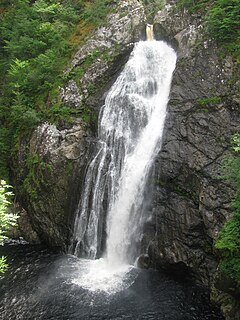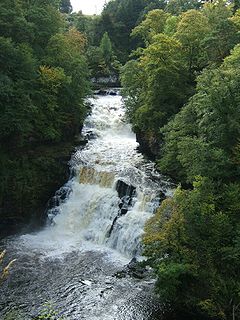
South Lanarkshire is one of 32 unitary authorities of Scotland. It borders the south-east of the City of Glasgow and contains some of Greater Glasgow's suburban towns, also containing many rural towns and villages. It also shares borders with Dumfries and Galloway, East Ayrshire, East Renfrewshire, North Lanarkshire, the Scottish Borders and West Lothian. It includes most of the historic county of Lanarkshire.

Falls of Clyde is the last surviving iron-hulled, four-masted full-rigged ship, and the only remaining sail-driven oil tanker. Designated a U.S. National Historic Landmark in 1989, she is now a museum ship in Honolulu, but her condition has deteriorated. She is currently not open to the public. In September 2008, ownership was transferred to a new nonprofit organization, the Friends of Falls of Clyde. Efforts to raise $1.5 million to get the ship into drydock did not succeed. On February 7, 2019 the Hawaii Department of Transportation (HDOT) put the ship up for auction. In November 2021 HDOT accepted a bid from Save Falls of Clyde – International (FOCI) to transport the ship to Scotland for restoration.

The Falls of Clyde is the collective name of four linn on the River Clyde near New Lanark, South Lanarkshire, Scotland. The Falls of Clyde comprise the upper falls of Bonnington Linn, Corra Linn, Dundaff Linn, and the lower falls of Stonebyres Linn. Corra Linn is the highest, with a fall of 26 metres (84 ft). Bonnington Linn, Corra Linn and Dundaff Linn are above New Lanark and located within the Falls of Clyde Reserve managed by the Scottish Wildlife Trust, a national nature conservation charity. Stonebyres Linn is located several miles downstream from the reserve and New Lanark.

The Rotten Calder is a river to the east of East Kilbride, South Lanarkshire, Scotland and along with the Rotten Burn it forms the southern and western boundaries of Blantyre.

The Fall of Foyers is a waterfall on the River Foyers, which feeds Loch Ness, in Highland, Scotland, United Kingdom. It is located on the lower portion of the River Foyers, and drops 165 feet (50 m).

The Clyde Walkway is a foot and mountain bike path which runs from Glasgow, Scotland, to just above the UNESCO World Heritage Site of New Lanark. The path runs close to the River Clyde for most of its length. It was completed in 2005, and is now designated as one of Scotland's Great Trails by NatureScot. The route is 65 kilometres (40 mi) long, and combines rural sections on the upper Clyde in South Lanarkshire, including the Clyde Valley Woodlands National Nature Reserve and the Falls of Clyde, with urban walking through the centre of Glasgow. About 155,000 people use the path every year, of whom about 7,750 undertake multi-day journeys including those covering the entire route.
William Todd Lithgow (1854–1908) was a Scottish ship-designer who became sole owner of an extremely successful shipbuilding company. For much of the 20th century its name was Lithgows, as it was developed further by William's sons Sir James Lithgow (1883–1952) and Henry Lithgow (1886–1948), and then by his grandson Sir William Lithgow. By 1950 it was the largest private shipbuilding company in the world.

The Falls of Halladale was a four-masted iron-hulled barque that was built in 1886 for the long-distance bulk carrier trade. Her dimensions were 83.87m x 12.64m x 7.23m and she displaced 2,085 GRT and 2,026 NRT. Built for the Falls Line at the shipyard of Russell & Co., Greenock on the River Clyde, she was named after a waterfall on the Halladale River in the Caithness district of Scotland. The ship's design was advanced for her time, incorporating features that improved crew safety and efficiency such as elevated bridges to allow the crew to move between forward and aft in relative safety during heavy seas.
This is a list of placenames in Scotland which have subsequently been applied to parts of New Zealand by Scottish emigrants or explorers.
The Bonnington Pavilion or Hall of Mirrors, now a ruin, is situated in the grounds of the old estate of Bonnington, near New Lanark, overlooking Corra Linn falls on the River Clyde in Lanarkshire, Scotland. Alternative names are the Corra Linn Pavilion and the Falls of Clyde summerhouse. It is said to have been the first Camera obscura built in Scotland. The name comes from the Gaelic 'currach', a marshy place. A legend gives 'Cora' as a daughter of King Malcolm II, who leapt to her death here whilst trying to escape imagined danger.

The Teviot Falls is a plunge waterfall in the Darling Downs region of Queensland, Australia.
Falls of Clyde may refer to:

The Clyde Valley Woodlands National Nature Reserve (NNR) comprises six separate woodland sites in the Clyde Valley region of South Lanarkshire, Scotland. These six sites are located along a 12 km section of the River Clyde and its tributaries, and lie close to built-up areas such as Hamilton and Lanark on the southern outskirts of Greater Glasgow. The sites can be easily accessed by about two million people living in the surrounding urban areas, making the reserve unique amongst Scotland's NNRs, most of which tend to be located in more remote areas. The six sites are:
Stonebyres was an estate and country house in Lanarkshire, Scotland, belonging to the Weir, or de Vere, family from earliest recorded history. The Weir-de Veres were a cadet branch of the Weir family of Blackwood but were a powerful and sometimes rival branch of the laird of Blackwood, head of Clan Weir. The laird of Stonebyres was often styled Baron Stonebyres.

The Lanark Hydro Electric Scheme refers to two hydroelectric plants in the Clydesdale area of South Lanarkshire, Scotland. They take in water from the Falls of Clyde.

Corra Castle is a ruined 16th-century castle within the Corehouse Estate near New Lanark, Scotland. It overlooks Corra Linn, one of the four waterfalls which make up the Falls of Clyde. In 1967 it became a scheduled monument.












